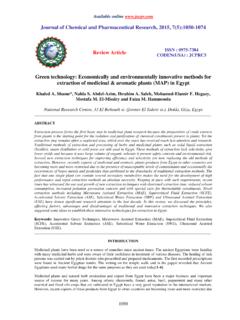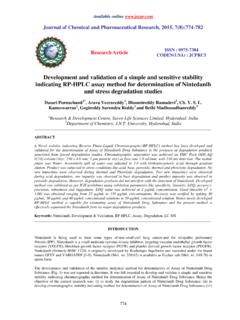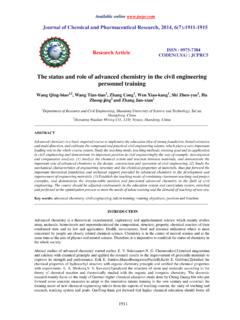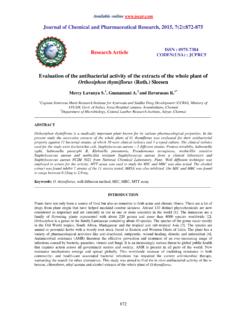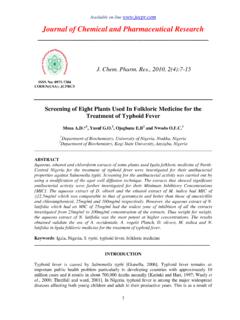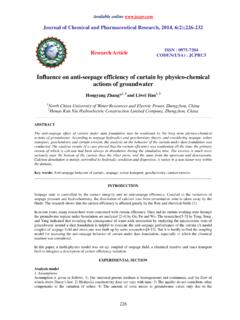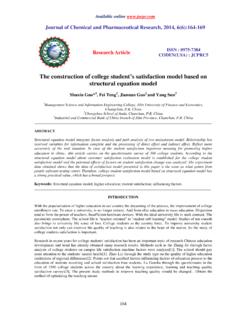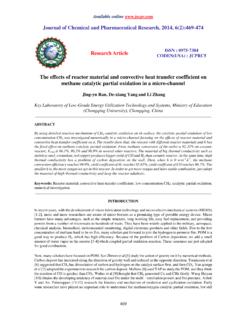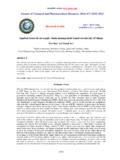Transcription of Research Article ISSN : 0975-7384 CODEN(USA) : JCPRC5
1 Available online Journal of Chemical and Pharmaceutical Research , 2016, 8(3):340-347 Research Article issn : 0975 - 7384 coden (USA) : JCPRC5 340 Synthesis, characterization and performance of hydroxyapatite coated 316L stainless steel Meenachi P. and Subashini R.* Department of Biomedical Engineering, SSN College of Engineering, Kalavakkam, Tamil Nadu, Chennai 603 110, India _____ ABSTRACT Hydroxyapatite, a major component and an essential ingredient of normal bone and teeth were synthesized by wet precipitation method. 316L Stainless steel (SS) are widely used for implantation in orthopedic surgery owing to corrosion resistance, mechanical property and low cost. Even though 316L SS are continuously being developed to replace implant materials used in the past, clinical studies show that these materials are also prone to corrosion to a certain extent. The localized corrosion attacks and discharge of metallic ions from implants demand improvement in the corrosion resistance of the currently used type 316L SS by modifying the surface.
2 HAP coating was proposed to decrease the corrosion rate and improve the bioactivity of 316L SS. The surface morphology and elemental analysis of coated HAP powder on 316L SS substrate was investigated using Field Emission Scanning Electron Microscope (FESEM) and Energy Dispersive X-ray Spectroscopy (EDAX). From the results of X-Ray Diffraction (XRD) study, the peaks correspond to crystallographic structure of HAP in the coated surface. The presence of functional group bands of HAP coating was studied using Fourier Transform Infrared Spectroscopy (FTIR). The surface roughness, film stress and coating thickness were determined by stylus Profilometer Dektak XT. The electrochemical potentiodynamic polarization tests were performed in physiological solutions at 37 1 C to investigate the corrosion behavior of uncoated and HAP coated 316L SS.
3 Thus, it was observed from the experimental data that the developed HAP coating on 316L SS substrate would be ideal for orthopedic applications. Keywords: Hydroxyapatite, Stainless steel, film stress, electrophoretic deposition, surface roughness. _____ INTRODUCTION Biocompatibility of metallic biomaterial is now a fundamental requirement of successful clinical behavior in orthopedic applications. Metallic biomaterials have a long history of use as implants and the type of metals used in biomedical applications depends on specific implants. The three commonly available materials used for implants are stainless steel (SS), cobalt chromium and titanium alloys. Among these medical grade 316L SS is generally used as implant material in India for orthopedic applications due to its excellent mechanical properties, ease of fabrication and low cost [1]. But it has been reported that 316L SS undergoes corrosion in vivo and causes the release of metal ions like Fe, Cr and Ni [2].
4 The wear and corrosion rate of metals change the chemical environment around the implant inducing the acidic pH and damage the surrounding tissues. These degradation products of corrosion result in inflammatory response locally and systematically [3]. For instance, the previous investigations reported that 90% of 316L SS implant devices failed due to localized corrosion such as pitting and crevice [4]. This revealed the importance of controlling the corrosion rate of the alloy in the human body and it can be achieved by using different surface modifications methods such as alloying, different chemical treatments, bioactive coatings etc. [5]. Among them, Hydroxyapatite (HAP) coating are well recognized because of their excellent biocompatibility and bioactivity properties. Meenachi P. and Subashini R. J. Chem. Pharm. Res., 2016, 8(3):340-347 _____ 341 HAP is an important material for bone and dental implants and it provides better osseo-integration between bone and implants and surface protection against body fluids [6].
5 The potent of using HAP coating on metal implants is due to the similarity of chemical composition with hard tissues where metals provide the advantage of necessary mechanical features while HAP supplies needful biological properties [1]. Various methods of HAP coating developed to improve the wear and corrosion resistance of metallic implants. These include plasma spraying, sputtering, electrophoretic deposition [7] and sol-gel. Among all the above methods electrophoretic deposition plays a vital role due to many advantages such as: (a) possibility to deposit stoichiometric (b) ease of obtaining the desired thickness and high layer adhesion to the substrate (c) easy control on film thickness (d) excellent homogeneity (e) ability to coat complex shape (f) equipments can be assembled at low cost (g) low temperature in processing [8]. Hence, in the present study electrophoretic deposition was attempted to develop HAP coating on 316L SS.
6 The main objective of this paper is to obtain HAP powder by wet precipitation method and coating on 316L SS by electrophoretic deposition method. The structural and morphological properties of HAP coated substrate were characterized by XRD, FESEM with EDAX. The chemical bonding present in the coated substrate was investigated by FTIR spectrometer. The corrosion behavior was measured in Ringer solution for coated and uncoated specimen by potentiodynamic polarization technique. The surface roughness, coating thickness, film stress was determined by stylus Profilometer Dektak XT. Hence, the present work is to achieve the HAP coating on 316L SS for improving the corrosion protection properties of the coatings. EXPERIMENTAL SECTION Preparation method of hydroxyapatite HAP powders were prepared using wet precipitation method. The starting materials used in the synthesis of HAP were analytical grade reagents, the calcium nitrate tetra hydrate and diammonium hydrogen phosphate.
7 The stoichiometric HAP was prepared based on the following modified wet chemical method [9]. The electrolyte used for the deposition of HAP on 316L SS was prepared by taking 1M solution of calcium nitrate tetra hydrate (Ca(NO3) ) and solution of diammonium hydrogen phosphate ((NH4)2 HPO4) to attain Ca/P ratio of The pH of the above solutions was retained by ammonia (NH4OH). After balancing the pH, solution of diammonium hydrogen phosphate was added drop-wise into calcium nitrate tetra-hydrate on to a magnetic steering maintained at 700 rpm and left undisturbed for 2 hrs. The particle size of the formed hydroxyapatite was dependent on the stirring time, if steering time is more, the particle size gets smaller. Then, the synthesized HAP was filtered with the help of whatsman No: 1 filter paper. The precipitate obtained was washed with ethanol to remove the suspended impurities and followed by drying in hot air oven for 1hr at 80 C.
8 After dehydrating, the HAP was crushed into powder using pestle motor. The crushed powder of HAP was sintered at 800 C in muffle furnace for 1hr. Electrophoretic deposition Electrophoretic deposition is a two-step process. In the first step, particles suspended in a liquid medium are forced to migrate towards an electrode under the influence of electric field applied to the suspension. In the second step, the particles are collected at one of the electrodes and formed a relatively dense and homogeneous compact film [10]. Several organic solvents are used for electrophoretic deposition, while in the current study deposition of hydroxyapatite on 316L SS was carried out by stirring 1gm hydroxyapatite powder in 50 ml of isopropyl alcohol for 30mins [11]. The sample 316L SS acts as cathode and 314L SS as anode. Both were immersed in suspension containing beaker.
9 Coatings were carried out at a constant voltage of 40V for 5-10 mins at room temperature. The distance between the electrodes was 1-2 cm. The coatings were obtained on cathodized substrates and sintered in vacuum furnace at 800 C for 2 hrs. Since, the substrate surface induces decomposition above 900 C the above temperature was maintained [12]. Characterization technique The phase purity of the HAP coated substrate was determined by X-ray diffraction (XRD) analysis (Rigaku) with Cu K radiation with scan step and scan speed 3 /min from diffraction angle of 20 to 80 at 40 kV and 100mA. The functional groups of HAP coated 316L SS substrates were characterized by FTIR spectrometer (Perklin Elmer Spect Two with a wave length range from 400 4000 cm-1 with precision of 4cm-1 and resolution software). The surface morphology was observed with Carl Zeiss SUPRA-55 Field emission scanning electron microscope (FESEM).
10 The elemental composition of the HAP coated 316L SS substrate was identified using Energy Dispersive X-ray spectroscopy (EDAX). The surface roughness, coating thickness and film stress was determined by stylus Profilometer Dektak XT. Meenachi P. and Subashini R. J. Chem. Pharm. Res., 2016, 8(3):340-347 _____ 342 RESULTS AND DISCUSSION High bioactivity can be achieved by performing the coating in conditions that is near to the human internal environment. Bioceramics plays a dual role both in preventing the release of metal ions and also in making the metal surface bioactive. Hydroxyapatite (bioceramic) is the most stable calcium phosphate compound under physiological conditions such as temperature, pH and composition of the body fluids. Stoichiometric HAP is stable in vacuum at temperatures below 1000 C, sintering of HAP coatings in high temperature causes diffusion of phosphorus into the substrate and as a result HAP partially decomposes to form tetra-tricalcium phosphate (TTCP) with a higher Ca/P ratio [13].
